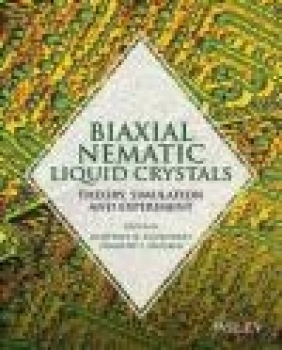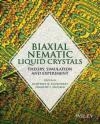Biaxial Nematic Liquid Crystals
G.R. Luckhurst
Biaxial Nematic Liquid Crystals
G.R. Luckhurst
- Producent: Blackwell Science
- Rok produkcji: 2014
- ISBN: 9780470871959
- Ilość stron: 408
- Oprawa: Twarda
Niedostępna
Opis: Biaxial Nematic Liquid Crystals - G.R. Luckhurst
Liquid Crystals are a state of matter that have properties between those of conventional liquid and those of a solid crystal. Thermotropic liquid crystals react to changes in temperature or, in some cases, pressure. The reaction of lyotropic liquid crystals, which are used in the manufacture of soaps and detergents, depends on the type of solvent they are mixed with.
Since the accidental discovery of the chiral nematic (ordered) phase in 1888 many liquid crystal phases have been found, sometimes by chance and sometimes by design. The existence of one such phase was predicted by Freiser in 1970, this was the biaxial nematic phase which has biaxial symmetry in contrast to that of the ubiquitous nematic phase which ix uniaxial. The biaxial symmetry of the predicted phase confers on it an additional layer of fascinating complexity.
This book is devoted to the biaxial nematic phase, both lyotropic and thermotropic, formed by low molar mass as well as polymeric systems. It brings together theory, simulations and experimental studies. The book opens with a general introduction to the biaxial nematic phase, while chapters 2-7 discuss current theories and predictions. Chapters 8 and 9 report on alignment and applications, while chapters 10.1 -10.5 detail characterization with the goal of unambiguous identification. Final chapters (11-14) cover Lyotropic, Colloidal, Thermotropic and Low Molar Mass Thermotropic Systems respectively.
About the Editors xiii
List of Contributors xv
Preface xvii
1 Introduction 1 Geoffrey R. Luckhurst and Timothy J. Sluckin
1.1 Historical Background 1
1.2 Freiser Theory 3
1.3 Nematic Order Parameters 4
1.4 Nematic Tensor Order Parameters 5
1.5 Theoretical Phase Diagrams 6
1.6 Landau de Gennes Theory 9
1.7 Computer Simulation 10
1.8 Other Theoretical Issues 11
1.9 Applications 12
1.10 Characterisation 12
1.11 Lyotropic and Colloidal Systems 14
1.12 Molecular Design 15
References 19
2 Biaxial Nematics: Order Parameters and Distribution Functions 25 Geoffrey R. Luckhurst
2.1 Introduction 25
2.2 The Cartesian Language 26
2.2.1 Order Parameters 26
2.2.2 Molecular Symmetry 28
2.2.3 Measurement 30
2.3 The Spherical Tensor Language 31
2.3.1 The Order Parameters of Biaxial Molecules in a Uniaxial Phase 31
2.3.2 Molecular Symmetry 33
2.3.3 Measurement 33
2.4 Extension to Biaxial Nematics 35
2.4.1 Orientational Order Parameters 35
2.4.2 Systems with D2h Point Group Symmetry 36
2.4.3 Measurement of the Order Parameters 37
2.4.4 Systems with C2h Point Group Symmetry and Their Order Parameters 38
2.4.5 Systems with C2h Point Group Symmetry: The Cartesian Language 39
2.5 Fourth-Rank Order Parameters 42
2.6 The Singlet Orientational Distribution Function 44
2.7 Appendices 47
2.7.1 Point Group Symmetry and the Associated Symmetry Operations 47
2.7.2 Legendre Polynomials, Modified Spherical Harmonics and Wigner Rotation Matrices 48
Acknowledgements 51
References 51
3 Molecular Field Theory 55 Epifanio G. Virga
3.1 Introduction 55
3.2 General Mathematical Theory 57
3.2.1 Two-Particle Hamiltonian 57
3.2.2 Ensemble Potentials 62
3.2.3 Molecular Field Approximation 65
3.2.4 Variational Principles 69
3.2.5 Local Stability Criterion 71
3.3 Non-Polar Molecules 74
3.3.1 Quadrupolar Hamiltonians 74
3.3.2 Phase Transitions 80
3.3.3 Universal Phase Diagram 87
3.3.4 Steric Effects 91
3.4 Polar Molecules 99
3.4.1 Dipolar Fluids 100
3.4.2 Dipolar Hamiltonian 102
3.4.3 Condensed Polar Phases 107
References 112
4 Hard Particle Theories 117 Andrew J. Masters
4.1 Introduction 117
4.2 Theoretical Approaches 119
4.3 Board-Like Models 122
4.4 Bent-Core Models 124
4.5 Rod Plate Mixtures 125
4.6 Conclusions and Speculations 128
Acknowledgements 129
References 129
5 Landau Theory of Nematic Phases 133 Lech Longa
5.1 Introduction 133
5.2 Symmetry of Biaxial Nematics and Primary Order Parameters 134
5.3 Landau Expansion 136
5.3.1 Generic NU I Phase Transition 136
5.3.2 Generic NB NU and NB I Phase Transitions 138
5.3.3 Role of Coupling between Nematic Order Parameters 141
5.3.4 Landau de Gennes Expansion in Terms of the Alignment Tensor 145
5.4 Conclusion 149
Acknowledgements 149
References 149
6 Computer Simulations of Biaxial Nematics 153 Roberto Berardi and Claudio Zannoni
6.1 Introduction 153
6.2 Order Parameters 156
6.3 Model Potentials and Applications 159
6.3.1 Lattice Models 159
6.3.2 Atomistic Models 162
6.3.3 Molecular Models 163
6.4 Conclusion 171
Acknowledgements 173
6.5 Appendices 173
6.5.1 Quaternions 173
6.5.2 Angular Momentum Operator 174
6.5.3 Kinematic and Dynamic Equations of Rotational Motion 175
6.5.4 Propagator/Integrator of Rotational Equations of Motion 176
6.5.5 Gradient of the Biaxial Gay Berne Potential 176
6.5.6 Torques of the Biaxial Gay Berne Potential 177
References 178
7 Continuum Theory of Biaxial Nematic Liquid Crystals 185 Iain W. Stewart
7.1 Introduction 185
7.2 Continuum Model and Energies 186
7.2.1 The Elastic Energy 187
7.2.2 The Magnetic and Electric Energies 187
7.2.3 The Total Energy 189
7.3 Dynamic Equations 189
7.3.1 Balance Laws 190
7.3.2 The Viscous Stress 192
7.3.3 The Dynamic Equations 194
7.3.4 Euler Angle Description 195
7.3.5 A Simple Shear Flow 196
7.4 Equilibrium Equations 198
7.4.1 The Equilibrium Equations 199
7.4.2 Alignment Induced by a Magnetic Field 200
7.5 Conclusion 202
References 202
8 The Alignment of Biaxial Nematics 205 Demetri J. Photinos
8.1 Introduction 205
8.2 Alignment by an External Electric or Magnetic Field 206
8.3 Surface Alignment 208
8.3.1 Macroscopic Description 208
8.3.2 Molecular Scale Description 210
8.4 Flow Alignment 210
8.5 Lower Symmetry Biaxial Nematics and Hierarchical Domain Structures 211
Acknowledgements 212
References 212
9 Applications 215 Paul D. Brimicombe
9.1 Introduction 215
9.1.1 Materials Considerations 215
9.1.2 Surface Alignment 216
9.2 Thin-Film Electro-Optic Devices 217
9.2.1 Minor-Director In-Plane Switching Devices 218
9.2.2 Electric Field-Induced Biaxiality Effects 220
9.2.3 Planar Biaxial Nematic Devices 221
9.2.4 Twist Effects in Biaxial Nematics and Biaxial Pi-Cells 222
9.2.5 Bistable Biaxial Nematic Devices 223
9.2.6 Spontaneous Chirality Effects 224
9.3 Non-Device Applications of Biaxial Nematic Liquid Crystals 225
9.3.1 Optical Compensation Films 225
9.4 Conclusion 225
References 226
10 Characterisation 229
10.1 Textures of Nematic Liquid Crystals 230 Ingo Dierking
10.1.1 Polarising Microscopy 230
10.1.2 Simple Liquid Crystal Optics 230
10.1.3 Optical Biaxiality 232
10.1.4 Textures 234
References 240
10.2 Refractive Index Studies 242 Antonio J. Palangana
10.2.1 Introduction 242
10.2.2 Optical Indicatrix 242
10.2.3 Optical Conoscopy 244
10.2.4 Results 246
10.2.5 Acknowledgements 250
References 250
10.3 Orientational Order Parameters of Nematic Liquid Crystals Determined by Infrared and Raman Spectroscopy 251 Jagdish K. Vij and Antoni Kocot 10.3.1 Introduction 252
10.3.2 Polarised IR Spectroscopy 252
10.3.3 Scalar Order Parameters of a Second-Rank Tensor 252
10.3.4 IR Absorbance Components 254
10.3.5 Experimental Method 256
10.3.6 Results for the Order Parameters for the Tetrapodes 256
10.3.7 Discussion of the Order Parameters 258
10.3.8 Raman Spectroscopy 259
10.3.9 Comparisons of IR and Raman Spectroscopy for Determining Order Parameters 263
References 264
10.4 NMR Spectroscopy 265 Louis A. Madsen
10.4.1 Introduction: NMR Basics, Advantages and Limitations 265
10.4.2 Probing Orientational Order 266
10.4.3 Creating a Director Distribution to Observe Biaxiality 267
10.4.4 Spectral Analysis Considerations: Fitting and Rotational Modulations 268
10.4.5 Incorporating Deuterium: Direct Mesogen Labelling Versus Probe Solutes 270
10.4.6 Powder Spectra and Monodomain Spectra: Examples 271
10.4.7 Alternative and Emerging Methods 272
References 274
10.5 Structural Studies of Biaxial Nematics: X-Ray and Neutron Scattering 276 Patrick Davidson
10.5.1 Introduction 276
10.5.2 Theoretical Considerations 276
10.5.3 Experimental Details 279
10.5.4 Specificities of the Scattering by Different Kinds of Biaxial Nematics 280
References 283
11 Lyotropic Systems 285 Antonio M. Figueiredo Neto and Yves Galerne
11.1 Introduction 285
11.2 Phase Diagrams 286
11.3 The Potassium Laurate Decanol Water Mixture: A Working Example 287
11.4 The Intrinsically Biaxial Micelles Model 294
11.5 Theoretical Reconstruction of the Lyotropic Nematic Phase Diagram: a Landau-Like Approach 298
11.6 Conclusions 302
Acknowledgements 302
References 302
12 Colloidal Systems 305 Gert Jan Vroege
12.1 Introduction 305
12.2 Onsager Theory and Extensions 306
12.3 Special Features of Colloids and Colloidal Liquid Crystals 307
12.4 Biaxiality in Mixtures of Rods and Plates 308
12.5 Particles with Inherent Biaxial Shape 311
12.6 Concluding remarks 315
References 316
13 Thermotropic Systems: Biaxial Nematic Polymers 319 Anke Hoffmann, Felicitas Brommel, and Heino Finkelmann
13.1 Introduction 319
13.2 Main-Chain Liquid Crystal Polymers 321
13.3 Side-Chain Liquid Crystal Polymers 321
13.4 Comparison of Attachment Geometries Influence of Molecular Dynamics and Molecular Shape 327
13.5 Conclusion 330
References 330 14 Low Molar Mass Thermotropic Systems 333 Matthias Lehmann
14.1 Preamble 333
14.2 Introduction and General Considerations 333
14.3 Single Component 336
14.3.1 Biaxial Board-Shaped Mesogens 336
14.3.2 V-Shaped Nematogens 338
14.3.3 Multipodes 350
14.4 Mixtures 354
14.5 Concluding Remarks 360
References 360
15 Final Remarks 369 Geoffrey R. Luckhurst and Timothy J. Sluckin
References 373
Index 375
Szczegóły: Biaxial Nematic Liquid Crystals - G.R. Luckhurst
Tytuł: Biaxial Nematic Liquid Crystals
Autor: G.R. Luckhurst
Producent: Blackwell Science
ISBN: 9780470871959
Rok produkcji: 2014
Ilość stron: 408
Oprawa: Twarda
Waga: 0.93 kg



















